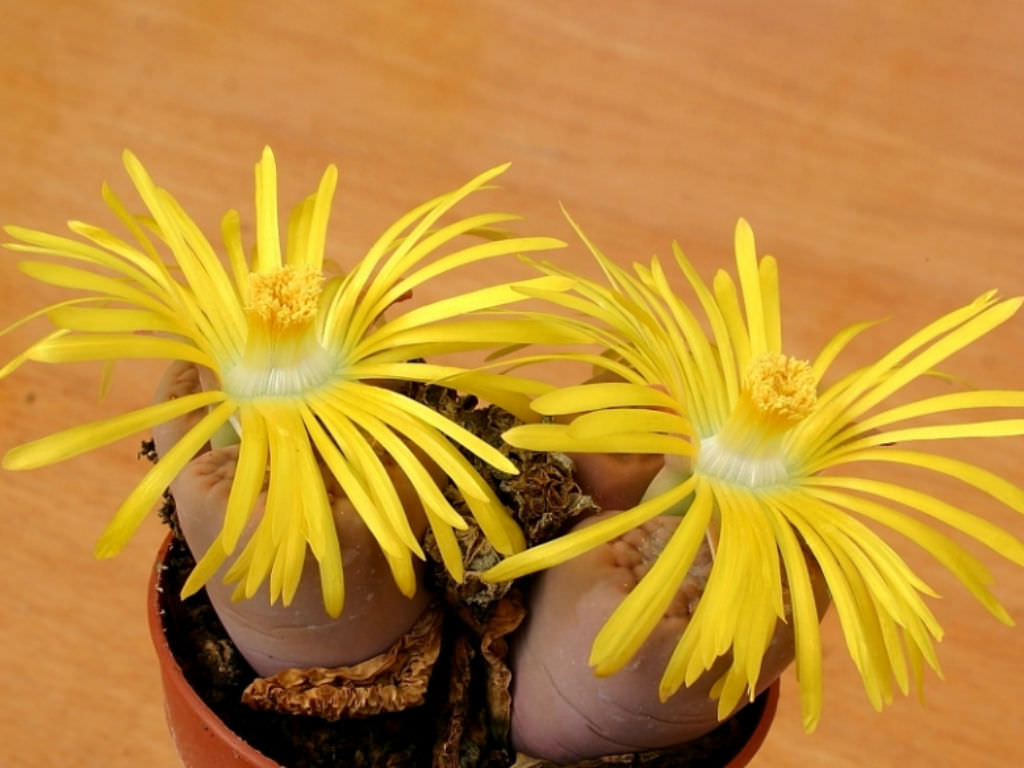Scientific Name
Lithops hookeri Schwantes
Common Name(s)
Living Stones
Synonym(s)
Lithops aurantiaca, Lithops dabneri, Lithops hookeri var. dabneri, Lithops hookeri var. elephina, Lithops hookeri var. lutea, Lithops hookeri var. marginata, Lithops hookeri var. subfenestrata, Lithops hookeri var. susannae, Lithops marginata, Lithops turbiniformis, Lithops turbiniformis var. brunneo-violacea, Lithops turbiniformis var. dabneri, Lithops turbiniformis var. elephina, Lithops turbiniformis var. lutea, Lithops turbiniformis var. marginata, Lithops turbiniformis var. subfenestrata, Lithops turbiniformis var. susannae, Mesembryanthemum hookeri, Mesembryanthemum turbiniforme
Scientific Classification
Family: Aizoaceae
Subfamily: Ruschioideae
Tribe: Ruschieae
Genus: Lithops
Origin
This species is native to South Africa (Northern Cape).
Description
Lithops hookeri is a small succulent with bodies composed of two thick fleshy leaves with flat to slightly convex upper surfaces. The bodies are up to 1.8 inches (4.5 cm) tall and 1.4 inches (3.5 cm) wide. The leaves come in a wide range of colors, from gray, brown, and red hues to pink and orange. They are also variable in the reticulated patterning of their upper surfaces. Older plants form clumps of up to 10 ten bodies. Flowers are yellow and appear in fall from the fissure between the leaves.
Etymology
The specific epithet "hookeri (HOOK-er-ee)" honors Sir William Jackson Hooker (1785-1865), an English botanist and botanical illustrator who was the first director of the Royal Botanic Gardens.

How to Grow and Care for Lithops hookeri
Light: Lithops have adapted to intense sunlight in the wild, so they require a good amount of direct sunlight when grown indoors.
Soil: These plants thrive best in a growing medium that will drain quickly. Use a commercial succulent soil mix or make your own potting mix.
Hardiness: Lithops hookeri can withstand temperatures as low as 30 to 50 °F (-1.1 to 10 °C), USDA hardiness zones 10a to 11b.
Watering: Lithops have a specific yearly cycle of growth, and it is important to water only during certain stages, but it is also important to keep the soil dry at other stages of their growth. Never water Lithops deeply when they are dormant.
Fertilizing: These succulents do not need to be fertilized. Lithops will thrive without any feeding. If you decide to feed, use a fertilizer with high potassium and low nitrogen levels.
Repotting: Lithops will happily stay in the same pot for several decades. The common reason for repotting is dividing the plants or allowing space for clusters to grow.
Propagation: If you have multi-headed plants, Lithops can be propagated by division. They are most often grown from seeds.
Learn more at How to Grow and Care for Lithops.
Toxicity of Lithops hookeri
Lithops are non-toxic and safe to have around children and pets.
Forms
Links
- Back to genus Lithops
- Succupedia: Browse succulents by Scientific Name, Common Name, Genus, Family, USDA Hardiness Zone, Origin, or cacti by Genus
Photo Gallery
Click on a photo to see a larger version.



